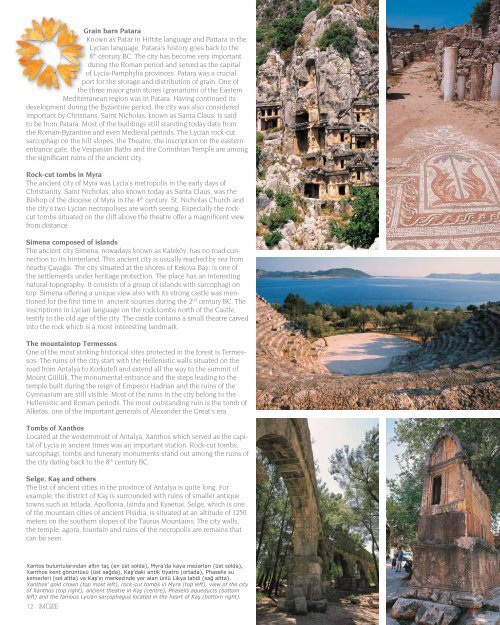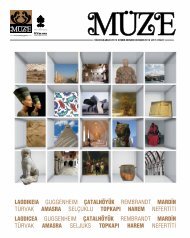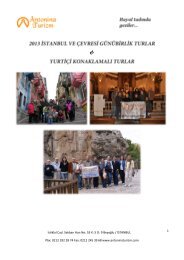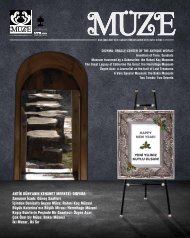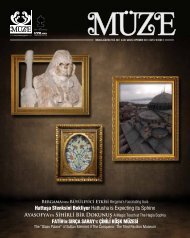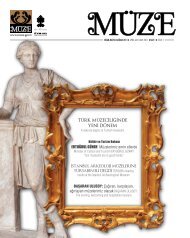DÃNYANIN YENÄ° YEDÄ° HARÄ°KASI SEVEN NEW WONDERS ... - MÃZE
DÃNYANIN YENÄ° YEDÄ° HARÄ°KASI SEVEN NEW WONDERS ... - MÃZE
DÃNYANIN YENÄ° YEDÄ° HARÄ°KASI SEVEN NEW WONDERS ... - MÃZE
You also want an ePaper? Increase the reach of your titles
YUMPU automatically turns print PDFs into web optimized ePapers that Google loves.
Grain barn PataraKnown as Patar in Hittite language and Pattara in theLycian language, Patara’s history goes back to the8 th century BC. The city has become very importantduring the Roman period and served as the capitalof Lycia-Pamphylia provinces. Patara was a crucialport for the storage and distribution of grain. One ofthe three major grain stores (granarium) of the EasternMediterranean region was in Patara. Having continued itsdevelopment during the Byzantine period, the city was also consideredimportant by Christians. Saint Nicholas, known as Santa Claus, is saidto be from Patara. Most of the buildings still standing today date fromthe Roman-Byzantine and even Medieval periods. The Lycian rock-cutsarcophagi on the hill slopes, the Theatre, the inscription on the easternentrance gate, the Vespasian Baths and the Corinthian Temple are amongthe significant ruins of the ancient city.Rock-cut tombs in MyraThe ancient city of Myra was Lycia’s metropolis in the early days ofChristianity. Saint Nicholas, also known today as Santa Claus, was theBishop of the diocese of Myra in the 4 th century. St. Nicholas Church andthe city’s two Lycian necropolises are worth seeing. Especially the rockcuttombs situated on the cliff above the theatre offer a magnificent viewfrom distance.Simena composed of islandsThe ancient city Simena, nowadays known as Kaleköy, has no road connectionto its hinterland. This ancient city is usually reached by sea fromnearby Çayağzı. The city situated at the shores of Kekova Bay, is one ofthe settlements under heritage protection. The place has an interestingnatural topography. It consists of a group of islands with sarcophagi ontop. Simena offering a unique view also with its strong castle was mentionedfor the first time in ancient sources during the 2 nd century BC. Theinscriptions in Lycian language on the rock tombs north of the Castle,testify to the old age of the city. The castle contains a small theatre carvedinto the rock which is a most interesting landmark.The mountaintop TermessosOne of the most striking historical sites protected in the forest is Termessos.The ruins of the city start with the Hellenistic walls situated on theroad from Antalya to Korkuteli and extend all the way to the summit ofMount Güllük. The monumental entrance and the steps leading to thetemple built during the reign of Emperor Hadrian and the ruins of theGymnasium are still visible. Most of the ruins in the city belong to theHellenistic and Roman periods. The most outstanding ruin is the tomb ofAlketas, one of the important generals of Alexander the Great’s era.Tombs of XanthosLocated at the westernmost of Antalya, Xanthos which served as the capitalof Lycia in ancient times was an important station. Rock-cut tombs,sarcophagi, tombs and funerary monuments stand out among the ruins ofthe city dating back to the 8 th century BC.Selge, Kaş and othersThe list of ancient cities in the province of Antalya is quite long. Forexample, the district of Kaş is surrounded with ruins of smaller antiquetowns such as Istlada, Apollonia, Isinda and Kyaenai. Selge, which is oneof the mountain cities of ancient Pisidia, is situated at an altitude of 1250meters on the southern slopes of the Taurus Mountains. The city walls,the temple, agora, fountain and ruins of the necropolis are remains thatcan be seen.Xantos buluntularından altın taç (en üst solda), Myra’da kaya mezarları (üst solda),Xanthos kent görüntüsü (üst sağda), Kaş’daki antik tiyatro (ortada), Phaselis sukemerleri (sol altta) ve Kaş’ın merkezinde yer alan ünlü Likya lahdi (sağ altta).Xanthos’ gold crown (top most left), rock-cut tombs in Myra (top left), view of the cityof Xanthos (top right), ancient theatre in Kaş (centre), Phaselis aqueducts (bottomleft) and the famous Lycian sarcophagus located in the heart of Kaş (bottom right).12


